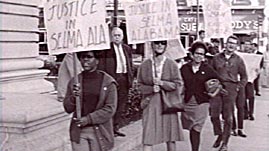After World War II, thousands of African Americans migrated away from the South's strict systems of segregation, but the battle for equality moved with them. For example, in 1947 the Fellowship of Reconciliation was formed in Chicago to address issues of racial inequality. By 1960, the Civil Rights movement had gained national attention, and activists from as far away as California were organizing.
In the early 1960s, African Americans made up roughly a quarter of the population of Oakland and San Francisco. Although they escaped the Jim Crow laws of the South, California's black population still hadn't found equality. Many business owners refused to hire black employees, limiting the job prospects and earning potential of African Americans.
Influenced by the student protests in the South, black and white students at the nearby University of California, Berkeley, organized a chapter of CORE, the Congress for Racial Equality, and planned nonviolent demonstrations to support equal rights and equal employment in the Bay Area. Together with other civil rights activists and local black organizations and churches, they formed the interracial Ad Hoc Committee to End Racial Discrimination.
The Ad Hoc Committee challenged discriminatory hiring practices by picketing businesses that refused to hire black employees. These demonstrations generated bad publicity for the businesses that discriminated, and encouraged boycotts. In 1964, the Committee successfully picketed local restaurants, car dealerships, and grocery stores in Oakland, Richmond, San Francisco, and Berkeley, with merchants agreeing to hire more African Americans. But success didn't come easily. At San Francisco's prestigious Sheraton-Palace Hotel, dozens of protesters were arrested before the hotel agreed to stop discriminating.
As part of the demonstrations, the Committee offered to stop picketing in exchange for job negotiations. This strategy gave merchants incentive to reconsider their hiring practices. The result was a citywide hiring agreement among 32 hotels, pledging to hire more African Americans. But the struggle for equal employment opportunities wasn't over. The next year, the Committee picketed the
Oakland Tribune and downtown businesses in Berkeley, with no success.

 Loading Standards
Loading Standards